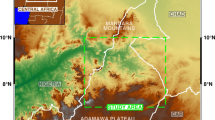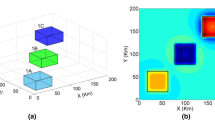Abstract
In the literature, there are numerous derivative-based transforms for gravity and magnetic data sets, with which relevant features can be highlighted. However, almost all of them face the problem of instability in derivative calculation. Therefore, before applying derivative-based transforms, noise reduction is often applied to improve the quality of the data. Nevertheless, the application of conventional filters typically blurs horizontal gradients in the data, which can adversely affect subsequent transforms, for example, the sharp boundaries of the causative bodies may be obscured. To handle the above issue, this study is the first to employ the bilateral filter, used in digital image processing, for improving the derivative-based transforms for gravity and magnetic data sets. The filter replaces each data point by a weighted average of its neighbors. The established weights take into account both the geometric and amplitude closeness between the data points used. Synthetic tests indicate that the proposed method can effectively filter potential field data without distorting the structural features greatly. Thus, the performance of subsequent derivative-based transforms can be improved. The new method was applied to the magnetic data collected over the Dapai polymetallic deposit in Fujian Province, South China. This real example shows that the results obtained from the proposed method contain more pronounced features of existing faults and thus contributes to further geological interpretation.
Similar content being viewed by others
References
Abedi M., Gholami A. and Norouzi G.H., 2012. A stable downward continuation of airborne magnetic data: A case study for mineral prospectivity mapping in Central Iran. Comput. Geosci., 52, 269–280.
Agarwal B.N.P. and Lal T., 1969. Calculation of the second vertical derivative of gravity field. Pure Appl. Geophys., 76, 5–16.
Baniamerian J., Liu S. and Abbas M.A., 2018. Stable computation of the vertical gradient of potential field data based on incorporating the smoothing filters. Pure Appl. Geophys., 175, 2785–2806.
Blakely R.J., 1995. Potential Theory in Gravity and Magnetic Applications. Cambridge University Press, Cambridge, U.K.
Cordell L., 1979. Gravimetric expression of graben faulting in Santa Fe Country and the Espanola Basin, New Mexico. New Mexico Geological Society Guidebook, 30th Field Conference, 59–64.
Essa K.S., 2007. Gravity data interpretation using the s-curves method. J. Geophys. Eng., 4, 204–213.
Fedi M., Lenarduzzi L., Primiceri, R. and Quarta T., 2000. Localized denoising filtering using the wavelet transform. Pure Appl. Geophys., 157, 1463–1491.
Fedi M. and Florio G., 2001. Detection of potential fields source boundaries by enhanced horizontal derivative method. Geophys. Prospect., 49, 40–58.
Ganguli S.S. and Dimri V.P., 2013. Interpretation of gravity data using eigenimage with Indian case study: A SVD approach. J. Appl. Geophys., 95, 23–35.
Hinze W.J., von Frese R.R.B. and Saad A.H., 2012. Gravity and Magnetic Exploration, Principles, Practices, and Applications. Cambridge University Press, Cambridge, U.K.
Honkasalo T., 1970. Geophysical interpretation of gravity anomalies. Stud. Geophys. Geod., 14, 254–263.
Luo Y., Marhoon M., Dossary S.A. and Alfaraj M., 2002. Edge-preserving smoothing and applications. The Leading Edge, 21, 136–158.
Lu Y.H. and Lu W.K., 2009. Edge-preserving polynomial fitting method to suppress random seismic noise. Geophysics, 74, 69–73.
Mesko A., 1984. Digital Filtering: Applications in Geophysical Exploration for Oil. Pitman Publishing, London, U.K.
Nabighian M.N., 1984. Toward a three-dimensional automatic interpretation of potential field data via generalized Hilbert transforms: Fundamental relations. Geophysics, 49, 780–786.
Oldenburg D.W., 1974. The inversion and interpretation of gravity anomalies. Geophysics, 39, 526–536.
Pašteka R., Richter F.P., Karcol R., Brazda K. and Hajach M., 2009. Regularized derivatives of potential fields and their role in semi-automated interpretation methods. Geophys. Prospect., 57, 507–516.
Prutkin I. and Saleh A., 2009. Gravity and magnetic data inversion for 3D topography of the Moho discontinuity in the northern Red Sea area, Egypt. J. Geodyn., 47, 237–245.
Prutkin I., Vajda P., Jahr T., Bleibinhaus F., Novak P. and Tenzer R., 2017. Interpretation of gravity and magnetic data with geological constraints for 3D structure of the Thuringian Basin, Germany. J. Appl. Geophys., 136, 35–41.
Prutkin I., Vajda P., Tenzer R. and Bielik M., 2011. 3D inversion of gravity data by separation of sources and the method of local corrections: Kolarovo gravity high case study. J. Appl. Geophys., 75, 472–478.
Roy I.G., 2013. On computing gradients of potential field data in the space domain. J. Geophys. Eng., 10, 035007.
Sobouti A., Motagh M. and Sharifi M.A., 2016. Inversion of surface gravity data for 3-D density modeling of geologic structures using total variation regularization. Stud. Geophys. Geod., 60, 69–90.
Tian Y.F., Li S.S., Liu X.G. and Fu G.F., 2009. Low-pass filter and its effect in data processing of aerial gravity measurements. J. Geodesy Geodyn., 29(6), 130–132.
Tomasi C. and Manduchi R., 1998. Bilateral filtering for gray and color images. Sixth International Conference on Computer Vision. The Institute of Electrical and Electronics Engineers, Inc., Piscataway, NJ, DOI: https://doi.org/10.1109/ICCV.1998.710815.
Wang J., Meng X.H., Guo L.H., Chen Z.X. and Li F., 2014, A correlation-based approach for determining the threshold value of singular value decomposition filtering for potential field data denoising. J. Geophys. Eng., 11, 055007.
Wang J., Meng X.H. and Li F., 2017a. New improvements for lineaments study of gravity data with improved Euler inversion and phase congruency of the field data. J. Appl. Geophys., 136, 326–334.
Wang J., Meng X.H. and Li F., 2017b. Fast Nonlinear generalized inversion of gravity data with application to the three dimensional crustal density structure of Sichuan Basin, Southwest China. Pure Appl. Geophys., 174, 4101–4117.
Wang J., Meng X.H., Guo L.H. and Li F., 2018. An empirical mode decomposition based noise cancelation method for potential field data along with a new stopping criterion. Arabian J. Geosci., 11, 418.
Yang J., Agterberg F.P. and Cheng Q.M., 2015. A novel filtering technique for enhancing mineralization associated geochemical and geophysical anomalies. Comput. Geosci., 79, 94–104.
Ye Z., Tenzer R. and Sneeuw N., 2018. Comparison of methods for a 3-D density inversion from airborne gravity gradiometry. Stud. Geophys. Geod., 62, 1–16.
Yuan S.Y. and Wang S.X., 2013. Edge-preserving noise reduction based on Bayesian inversion with directional difference constraints. J. Geophys. Eng., 10, 025001.
Yuan Y., Zhang D., Feng H.B., Di Y.J., Wang C.M. and Ni J.H., 2014. The Re-Os isotope geochronology of Dapai iron polymetallic ore deposit in Yongding county, Fujian province and its genetic significance. Acta Geologica Sinica, 88, 1025–1026.
Zeng X.N., Li X.H., Jia W.M., Chen D.X. and Liu D.Z., 2015. Iterative Wiener filter for unstable linear transformations of potential field data. J. Appl. Geophys., 115, 100–109.
Zhang Z., Zuo R. and Cheng Q., 2014. The mineralization age of the Makeng Fe deposit, South China: implications from U-Pb and Sm-Nd geochronology. Int. J. Earth Sci., 104, 663–682.
Author information
Authors and Affiliations
Corresponding authors
Rights and permissions
About this article
Cite this article
Wang, J., Meng, X. Employing the bilateral filter to improve the derivative-based transforms for gravity and magnetic data sets. Stud Geophys Geod 63, 215–228 (2019). https://doi.org/10.1007/s11200-018-0162-y
Received:
Revised:
Accepted:
Published:
Issue Date:
DOI: https://doi.org/10.1007/s11200-018-0162-y




